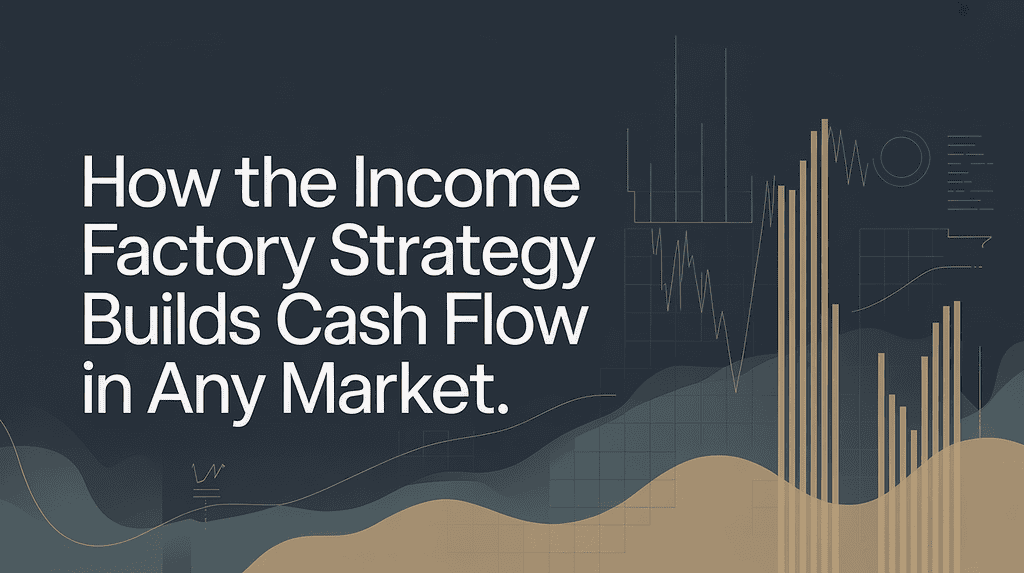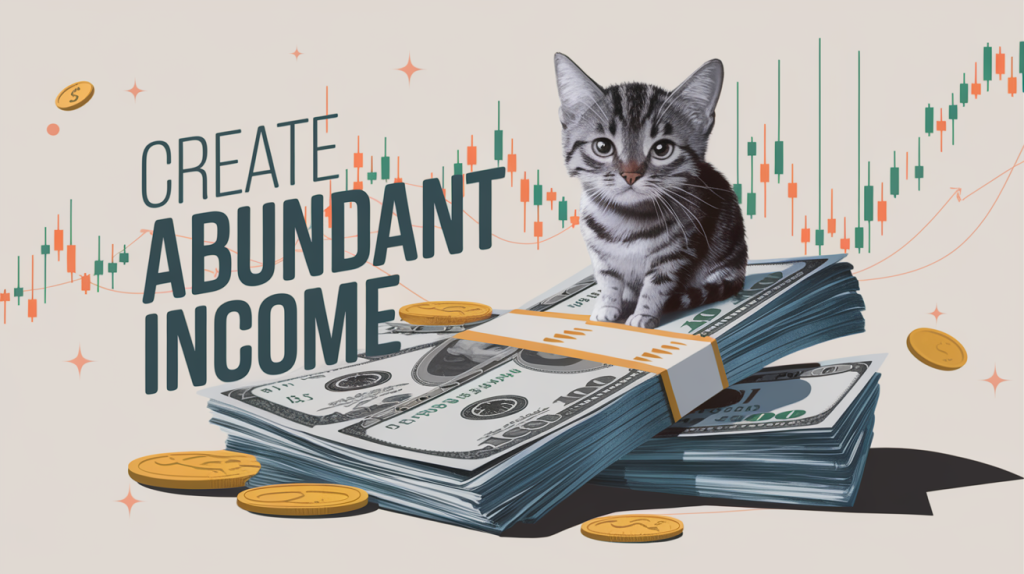
Get your own copy of the Income Factoy book
Introduction
You want a portfolio that works for you every week, every month, and in every market climate. As a sophisticated investor, you understand that traditional strategies rely on price appreciation, which can vanish the moment markets turn against you. The income factory takes a different path. Rather than hoping your assets rise in value, you intentionally build a portfolio designed to produce cash flow relentlessly, even in flat or declining markets. This article shows you how the strategy works, the assets that power it, and how to reinvest distributions so your income compounds steadily over time.
What Is the Income Factory Strategy?
Before evaluating the components of the strategy, you need clarity on what makes it fundamentally different from a growth-dependent approach.
An income factory treats your portfolio as a cash-producing machine. You focus on creating reliable, repeatable income streams; primarily through high-yield assets such as closed-end funds, covered call ETFs, bank loan funds, and option-income ETFs. Price appreciation becomes a secondary benefit. Cash flow becomes the main event.
This shifts your mindset from “What will the market give me?” to “What can my portfolio generate on its own?” When you prioritize steady income and redeploy it consistently, your wealth compounds from the bottom up, without relying on favorable market timing.
Why Cash Flow Is the Ultimate Shock Absorber
With the core philosophy in place, it becomes clear why dependable income is such a powerful stabilizer.
Income continues when markets fall. It continues when markets move sideways. And it continues when prices are volatile. That consistency allows you to reinvest during drawdowns, increasing your forward yield and improving your long-term compounding curve.
This effect mirrors volatility-harvesting concepts such as Shannon’s Demon. In a portfolio where assets fluctuate but regularly pay out income, each reinvestment captures volatility as a feature, not a bug. While traditional investors endure market whipsaws, your cash-flow engine remains productive throughout every cycle.
The result is that while in a falling market you will see your portfolio value decline, as long as the investments continue generating cash flow, you are able to reinvest at lower prices and accumulate more shares faster. When the market turns back up, these excess shares will make your portfolio value go higher faster. In a ideal scenario, you will not sweat a market downturn, but actually welcome it as an opportunity to accelerate your portfolio growth.
The Engine: High-Yield Assets That Power an Income Factory
With the theory established, we now look at the practical building blocks. Each asset class contributes a different rhythm of income, creating a balanced mix of yield sources.
Closed-End Funds (CEFs)
CEFs often trade at discounts to NAV and use structural leverage to boost distributions. They provide access to credit, preferreds, equity income, and more. Their structure makes them ideal for investors seeking high current income that can be reinvested at compelling yields.
Adding non-equity linked CEFs also add diversification to the portfolio by reducing equity exposure. Some CEFs offer exposure to the segments of the market that are otherwise not accessible to retail investors, such as CLOs, private credit and convertible bonds.
Covered Call ETFs
These ETFs generate premium income by selling call options. In flat or choppy markets, they are especially effective. While they may lag in sharp uptrends, their reliability helps anchor an income-first strategy. During the sideways market (which is most of the time), covered call ETFs excel in not only maintaining value, but as generating additional income that can be used to increase the shareholding.
Bank Loan and Floating-Rate Funds
These instruments reduce duration risk and offer income streams that adjust with interest rates. When rate cycles shift, floating-rate exposure stabilizes your portfolio’s overall yield.
Option-Income ETFs (Daily/Weekly Distribution ETFs)
ETFs such as QDTE, RDTE, WEEK, and others produce frequent cash flows through short-dated option structures. Their high cadence of distributions makes them an excellent fit for weekly reinvestment and rapid compounding. These can be considered risky, especially the ones that are leveraged plays, but higher income cadence opens up the possibility of using the cash flow to build positions in other instruments, quickly, and diversifying.
How the Income Factory Compounds Faster Than Price-Based Strategies
Once your income streams are in motion, the compounding engine accelerates.
Each payout becomes fresh capital you can redeploy. This expands the number of shares you hold (“growing wide”), which expands your future income even if prices remain flat. When transaction costs are zero and settlement is fast, the pace of compounding increases further.
Traditional investors wait for market appreciation that may or may not come. Income factory investors build more shares, more yield, and more future compounding regardless of market mood. Traditional investors think of compounding as growing up, while Income Factory achieves compounding by growing wide.
Position Sizing and Risk Controls in an Income Factory Portfolio
In a small-cap value strategy, you can calculate expected returns precisely enough to justify Kelly Criterion sizing. But with high-yield ETFs and CEFs, the payout structure depends on factors (credit spreads, option premiums, leverage policies, distribution coverage) that do not lend themselves to Kelly-based optimization.
For this reason, the most effective sizing model for an income factory is simple equal weighting.
Equal weighting offers three major advantages:
1. Natural diversification across income drivers
Instead of concentrating in one credit bucket or option strategy, equal weight spreads risk evenly. If one fund reduces distributions, others maintain portfolio stability.
2. Smooth weekly reinvestment
Your new cash automatically flows toward the lowest-weight holding, creating a natural buy-low mechanism without requiring forecasts. I assume that you have laddered your portfolio income to provide you with weekly cash flows.
3. Lower operational risk
Equal weight avoids accidental overweighting of leveraged or unstable funds. The portfolio stays balanced by design and easy to manage through any market environment.
With this approach, risk control focuses on three practical checks:
- Is the distribution being covered?
- Is the fund’s NAV stable or improving?
- Is the leverage profile appropriate for current conditions?
This produces a resilient, income-forward portfolio without relying on mathematical edge estimation. The objective here is reliable cash flow and consistent long-term compounding.
How an Income Factory Performs in Different Market Environments
With the allocation structure clarified, it becomes easier to understand how the portfolio behaves.
Rising Markets
Income assets still appreciate, though covered call ETFs may lag during violent rallies. But weekly reinvestment keeps your compounding engine moving, regardless of price behavior.
Falling Markets
Distributions continue even in downturns, allowing you to accumulate more shares at better yields. This makes recoveries faster and more profitable. Of course, keep an eye out for the leveraged assets.
Sideways Markets
This is where the income factory excels. While price-dependent strategies stall, your portfolio continues producing cash flow, reinvesting it, and growing steadily without waiting for external catalysts.
Rebalancing: The Quiet Multiplier of Income Factory Results
Equal weighting naturally reduces the need for complex rebalancing, but periodic adjustments strengthen results.
Weekly reinvestment is a form of micro-rebalancing.
Quarterly light rebalancing trims overweights and adds to underweights.
The effect mirrors the rebalancing bonus described by William Bernstein: you incrementally buy low and redirect excess from assets that have run ahead.
The portfolio remains stable, diversified, and compounding. I does not drift towards hidden concentrations.
Avoiding Mistakes: The Real Risks in High-Yield Investing
High yield attracts investors searching for shortcuts. But chasing the highest headline yield is a trap.
Instead, your focus should remain on:
- sustainable distributions
- healthy NAV trends
- responsible leverage
- funds with consistent coverage of their payouts
Income factories succeed because they operate with discipline, not because they chase extreme yield. Your long-term compounding depends on protecting the downside first. It is not set and forget investment. You still need to monitor and be ready to eliminate or replace assets that no longer fit the goal of your portfolio.
How to Build Your Own Income Factory Portfolio
With all principles aligned, constructing your portfolio becomes straightforward:
- Select a diversified set of high-yield assets
- Allocate using simple equal weighting
- Reinvest weekly into the lowest-weight holding
- Rebalance lightly each quarter
- Monitor distribution stability and leverage
This approach creates a reliable cash-flow engine that grows without demanding constant trading or deep analytical edge. It is scalable, durable, and easy to manage across years. We have a more detailed article about the construction of an income factory portfolio.
Why the Income Factory Belongs Alongside Small-Cap Value and Factor Strategies
Your income engine is not meant to replace your other portfolios, it strengthens them.
Weekly and monthly cash flow can be redirected into small-cap value, momentum factors, Dynamic Core Hedge exposures, or even Bitcoin. This creates a self-reinforcing ecosystem where one portfolio feeds another.
Or you can use your income factory distributions to support your lifestyle while your other portfolios grow and mature.
Your income factory lowers overall volatility, boosts liquidity, and accelerates the compounding across your entire investment framework.
Conclusion
I have run a small cap value portfolio for many years. While it has performed excellently over the years, it does leave the assets less liquid. If you need cash, there is no guarantee that it is an appropriate time to sell. Pairing it with an income factory portfolio takes away this concern.
The income factory delivers what growth-dependent strategies cannot: dependable, repeatable cash flow that compounds consistently in any market environment. While others ride the emotional waves of price volatility, your portfolio quietly produces income, reinvests it, and expands your purchasing power week after week.
If you want a portfolio that works every day of the year, regardless of market direction, the income factory gives you exactly that: a resilient, cash-flow-driven engine designed to build durable wealth over time.

Shailesh Kumar, MBA is the founder of Astute Investor’s Calculus, where he shares high-conviction small-cap value ideas, stock reports, and investing strategies.
His work has been featured in the New York Times and profiled on Wikipedia. He previously ran Value Stock Guide, one of the earliest value investing platforms online.
Subscribe to the Inner Circle to access premium stock reports and strategy insights.
Featured in:




